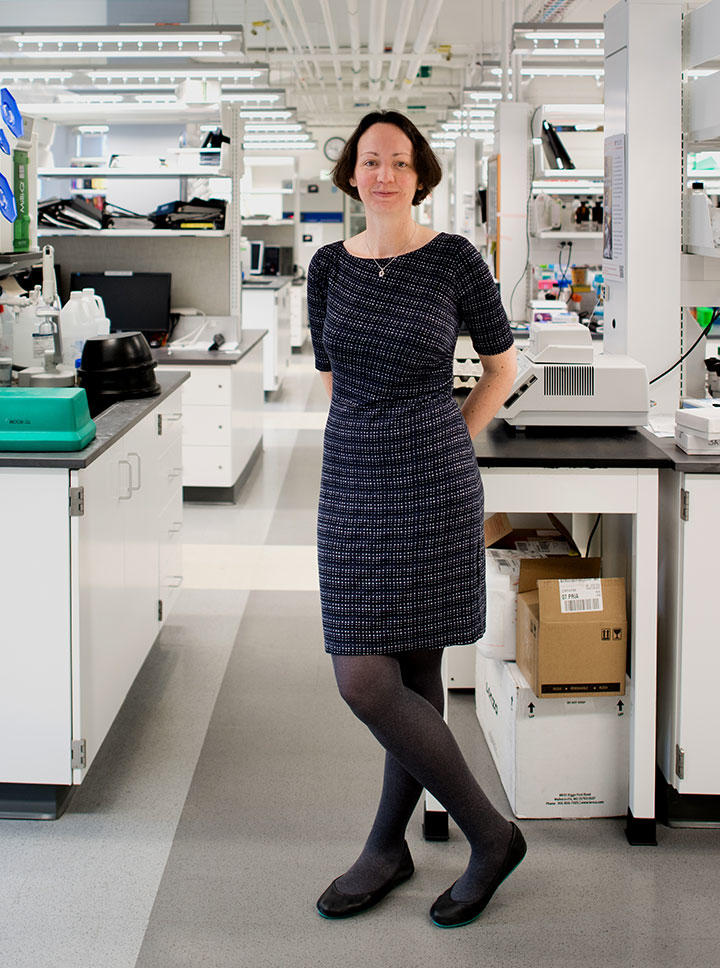Chemical and Biological Engineering: Slowing Cancer Cells
Princeton scientists discover a common trigger for metastasis
Tumors are generally rigid and blood vessels cannot easily penetrate them. These two factors combined create oxygen-devoid, or hypoxic, pockets. Celeste M. Nelson, a professor in the chemical and biological engineering and molecular biology departments, and her colleagues recently uncovered how rigid tissue and the subsequent hypoxia can lead to metastasis. The two combined conditions tended to trigger a protein called integrin-linked kinase (ILK) to behave abnormally in breast-cancer cells, which has been shown previously to initiate metastasis. The team’s findings could provide several new avenues to target and treat cancer.
Cancer cells communicate with their immediate environment, including the connective tissue that surrounds the tumor. Nelson’s lab focused on whether the stiff and oxygen-deficient neighborhood of tumor cells affects ILK, a signaling protein that is found in healthy cells, but tends to be found in higher levels in some tumor cells. “ILK is a protein that acts as an antenna for the cell — it senses its surroundings and relays [what it learns] back to the cell,” Nelson explains. ILK helps to regulate survival and migration of cells, but it is unknown how stiffness and hypoxia may change the activity of ILK to help drive the dispersal of cancer cells to other parts of the body.
By growing human breast-tumor cells within a mix of proteins that mimic the connective tissues that frame the cells in the body, the lab found that the combination of a stiff and hypoxic environment increased the levels of ILK in cells; these cells often would begin to take on properties of cancer stem cells — cells in the tumor thought to be responsible for metastasis.
Tracking how the breast-tumor cells moved over time in cultures both with and without oxygen, Nelson’s lab observed that the cells had greater mobility with decreased oxygen and increased stiffness of the surrounding connective medium compared to cells grown on a well-oxygenated, soft medium. When the ILK in the cells was depleted, even under the stiff and hypoxic conditions, the breast-tumor cells no longer behaved like cancer stem cells; however, adding more ILK to breast-tumor cells growing in a soft medium under normal oxygen levels could convert the cells into cancer stem cells.
Examining breast-tumor biopsies, the lab found similar results: The hypoxic regions had higher levels of ILK and cells likely to be cancer stem cells. “That’s quite a lot of evidence to suggest what we are seeing [in the lab] takes place in breast-cancer patients,” says Nelson.
Previously, it was understood that tumor hypoxia makes for a poorer prognosis and that when the connective tissue surrounding cells is stiff, tumor progression is more likely. But Nelson’s study is the first to hint that the two together tend to promote nefarious ILK signals that can lead to metastasis. For Nelson, this suggests that elevating oxygen levels and softening the area around tumor cells may be a possible cancer treatment. Another treatment could be to block the activity of ILK with a drug.
The lab is now trying to understand the other important molecules in the cancer cells that interact with ILK and will test whether ILK inhibitors can prevent the aggressive behavior of laboratory-grown breast-tumor cells. “We would like to move this study forward,” says Nelson, “to the point where we can help people.”












No responses yet